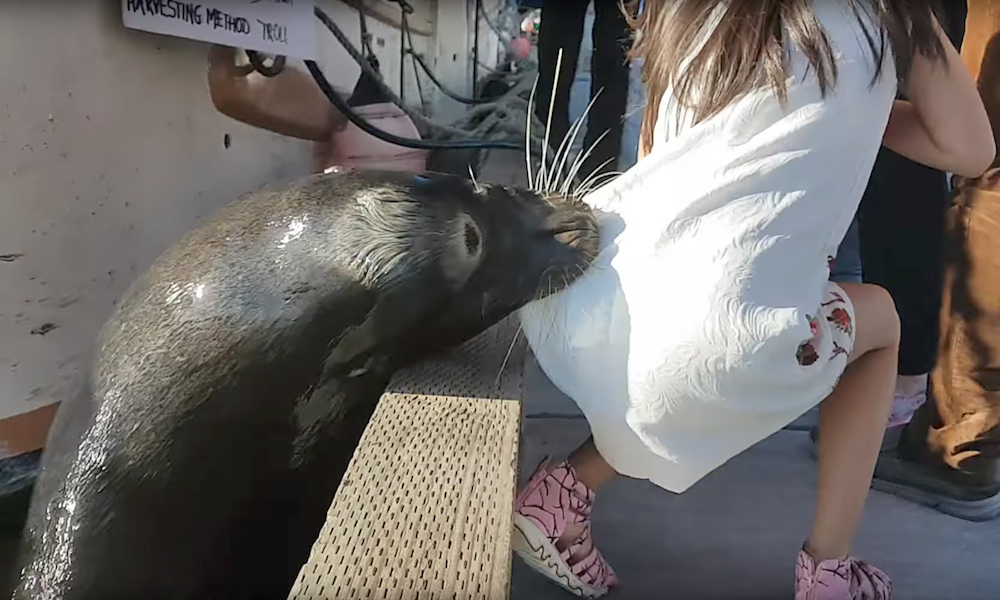Terrifying Video: Why a Sea Lion Pulled a Little Girl into the Water

It was a terrifying moment caught on video. A sea lion bobs its head in the water while a girl sits gingerly on the dock above. The next instant, the sea lion launches out of the water and pulls the girl in, but the animal releases her a few seconds later. A bystander caught the entire episode on a video that's been viewed more than 13 million times since it was posted to YouTube Saturday (May 20). But what made the sea lion grab the girl, only to release her an instant later?
It's impossible to know the animal's intentions, but the sea lion likely thought the girl's white dress was a piece of food, sea lion experts told Live Science. However, the marine mammal probably wasn't expecting the girl to fall on top of it, and likely let go of her in surprise, they said.
"My guess is that not only was the girl in shock; probably the sea lion was, too, by having something so large land on top of him," said Andrew Trites, director of the Marine Mammal Research Unit at the University of British Columbia, in Vancouver. [Images: Sea Lion Pups Make a Splash]
In the video, people watch and playfully call to the wild sea lion as it approaches a dock at Steveston Fisherman's Wharf in Richmond, British Columbia. Some of the people hold their hands close to the sea lion, pretending as though they have treats to feed it, even though they don't.
Meanwhile, a young girl kneels by the water to get a better look at the sea lion, and yells in surprise when it emerges halfway out of the water, likely to see if she has food. Then, the girl sits on the edge of the dock, and within a split second, the sea lion bites her dress and pulls her into the water.
Luckily, an adult jumped in to help the young girl, who was soaking wet but appeared physically unscathed, back onto the dock.
"I don't think it was a sign of an animal being aggressive or trying to harm the child," Trites told Live Science. "The animal was expecting food. They were basically not taunting, but probably unintentionally teasing the animal by not giving him any food."
Get the world’s most fascinating discoveries delivered straight to your inbox.
He noted that the first time the sea lion lunged at the girl, she moved away from the water. This move might have triggered the sea lion's predator response when it apparently mistook her dress for a tasty morsel, Trites said.
"When something flees, you go faster to grab it," he said. "You see that happening with cougars, with bears — you know, you [are supposed to] back away slowly from bears."
The sea lion is likely a male California sea lion (Zalophus californianus), Trites said. Male Z. californianus can weigh up to 800 lbs. (360 kilograms) and measure an average of 7 feet (2.1 meters) long, according to Sea Lion World.
Some male Z. californianus travel north to Canada during the winter and spring so they can build up blubber by gobbling down fish and squid. That way, "when they go back to California, they're big and attractive to the females that are on the breeding beaches, and can defend territories almost like sumo wrestlers," Trites said.
He advised people to give sea lions and other wild animals a wide berth, and not to feed them. Although Z. californianus is well-known, often for doing tricks in zoos, wild-animal behavior can be unpredictable, Trites said. [Marine Marvels: Spectacular Photos of Sea Creatures]
"Those people and the child were just way too close to the animal," he said. "I was so surprised that parents would put their child into that situation. You wouldn't let your child feed a bear, so why would you be encouraging it to feed a sea lion?"
Many sea lions are acclimated to being around people, especially fishers who might throw them a fish or inadvertently provide them a fishy meal when dumping leftover fish heads and guts into the water, said Pat Thomas, general curator at the Bronx Zoo in New York City.
"Sea lions are wild animals," Thomas said. "Admire them from a distance. They are amazingly beautiful, agile animals in the water, but you should never be so close that you're putting yourself at some risk because you're not going to know how it's going to respond to your presence."
Update on May 25: The girl is receiving antibiotic treatment as a precaution for "seal finger," a bacterial infection that can be transmitted from seals and sea lions to humans.
Original article on Live Science.

Laura is the managing editor at Live Science. She also runs the archaeology section and the Life's Little Mysteries series. Her work has appeared in The New York Times, Scholastic, Popular Science and Spectrum, a site on autism research. She has won multiple awards from the Society of Professional Journalists and the Washington Newspaper Publishers Association for her reporting at a weekly newspaper near Seattle. Laura holds a bachelor's degree in English literature and psychology from Washington University in St. Louis and a master's degree in science writing from NYU.


